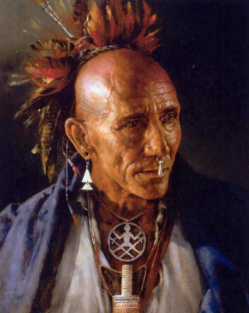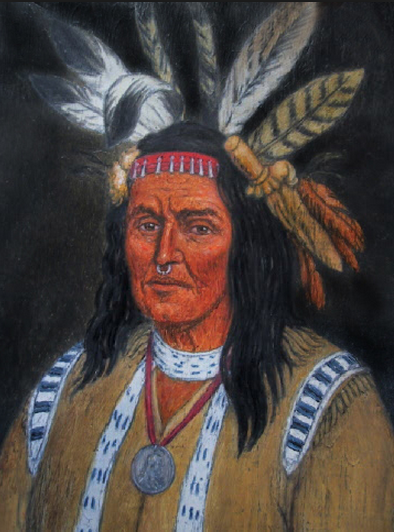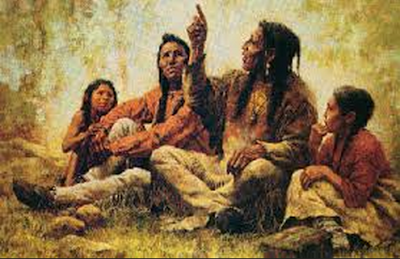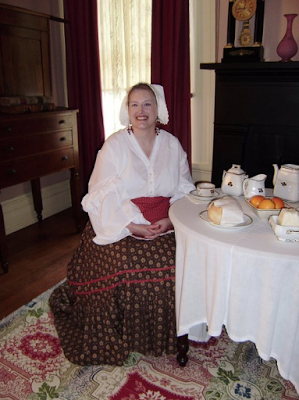Allison Bruning's Blog, page 7
June 7, 2016
#ToBeShawnee: A Tale of Two Chiefs
To Be Shawnee:
A Tale of Two Chiefs
 The very word unifies them as a nation. Yet in all of Shawnee history, the only time they ever came together as one people was when there was a threat against all Shawnee people. The Shawnee have always lived an independent lifestyle. To be an adult Shawnee meant you could live wherever you wanted without the need to answer to anyone. This allowed the Shawnee the freedom to settle anywhere which is why when the settlers began to explore the wilderness it was very easy for them to run into a Shawnee.
The very word unifies them as a nation. Yet in all of Shawnee history, the only time they ever came together as one people was when there was a threat against all Shawnee people. The Shawnee have always lived an independent lifestyle. To be an adult Shawnee meant you could live wherever you wanted without the need to answer to anyone. This allowed the Shawnee the freedom to settle anywhere which is why when the settlers began to explore the wilderness it was very easy for them to run into a Shawnee.
One of the problems the Europeans faced with the Shawnee people was the idea of political unity. The Europeans' concept of leadership was completely different than the Shawnee. They were coming for a culture where monarchy was the rule of the land. This meant everyone obeyed one leader. To the Shawnee this was a foreign concept. While they did have chiefs, they could leave the chief's leadership if they disagreed with the chief. So when a chief makes an agreement with another he is speaking for his village but if a person does not agree with the comprise he or she is free to leave without any political repercussions. The Europeans had expected if a compromise was made with a Shawnee chief then it was to be followed by all Shawnee. In the Shawnee's eyes, the compromise was made only with his or her village not the entire nation. The cultural differences in this belief often mistakenly lead the Europeans in conflict with the Shawnee.
Ideally the leadership of a village was lead under two chiefs, the peace chief and the war chief. The two did not come from the same division nor did they lead their people at the same time. Shawnee division were: Chillicothe (Chalahgawtha) [Chalaka, Chalakatha], Hathawekela (Asswikales, Sweickleys, etc.) [Thawikila], Kispokotha (Kispoko) [kishpoko, kishpokotha], Mequachake (Mekoche, Machachee, Maguck, Mackachack) [Mekoche] and Pekuwe (Piqua, Pekowi, Pickaway, Picks) [Pekowi, Pekowitha]. All villages had a council of elders that were like advisers to the chief. No chief could make a decision without seeking the advice of the elders. Council meetings were often held for three days.
The Peace Chief The peace chief came from the Chillicothe division. He was responsible for leading the villagein times of peace and only answered to the principal peace chief. The principal peace chief was the peace leader over of all the Shawnee. Each summer the village peace chiefs would travel to the principal peace chief's village for a great council. The position of peace chief was hereditary. It could only be passed from father to son. The principal chief was chosen from the independent village chiefs. A famous Shawnee peace chief was Chief Cornstalk.
The peace chief came from the Chillicothe division. He was responsible for leading the villagein times of peace and only answered to the principal peace chief. The principal peace chief was the peace leader over of all the Shawnee. Each summer the village peace chiefs would travel to the principal peace chief's village for a great council. The position of peace chief was hereditary. It could only be passed from father to son. The principal chief was chosen from the independent village chiefs. A famous Shawnee peace chief was Chief Cornstalk.
The peace chief's wife was known as the female peace chief. She had the responsibility of overseeing the female duties of the village, ordering when to plant and sow the fields and scheduled the cooking for the feasts. Women had a strong voice in the tribal government because the Shawnee honored women more than men.
The War ChiefOne of the most well-known war chiefs was Tecumseh.
The position of war chief was not hereditary. After the war chief died any Kishpoko could compete for the position. The competitors were given men underneath their leadership for the duration of three seperate village attacks. They had to prove themselves by gathering a scalp from each attack and arrive home without any of their warriors killed or injured. Than the man who could do this three times was said to be chosen by Our Grandmother to replace the war chief. A war chief could only come out of the Kishpoko division since these were the warriors of the Shawnee nation. Tecumseh's father was the principal war chief until his death when Tecumseh was still a boy. Tecumseh was too young at that time to fight for his father's position.
The war chief led the village during the times of war. He was also responsible for training all boys to become warriors and strong providers. Whenever the village was at war it would be the war chief who was in charge and not the peace chief. You could always tell the distinction between the chiefs because a war chief always wore a red tipped tomahawk on his hip. The war chief, like the peace chief, also answered to a principal chief and travelled in the summer to the a great council. Another responsibility of the war chief was to ensure law and order in the village. He was the emissary sent to other tribes to speak on behalf of his village. So more often, the Europeans, when they were encountering a village leader it was not the peace chief they were speaking too but the war chief. The war chief would not make a decision without consulting the peace chief first. This is why they rarely made a decision when speaking to the Europeans about anything. They would have to take the information back to the village, discuss it with the peace chief and council then deliver the decision to the tribe or Europeans. The Europeans did not understand this and often grew impatient waiting for their reply.
Like the peace chief, the war chief's wife also served beside her husband in the leadership of their people. Known as the war woman, she was responsible for examining the captives. If her husband was about to attack a village or kill a captive and she disapproved she could speak up against it. He could not act without her consent if she decided to protect them.
A Tale of Two Chiefs
 The very word unifies them as a nation. Yet in all of Shawnee history, the only time they ever came together as one people was when there was a threat against all Shawnee people. The Shawnee have always lived an independent lifestyle. To be an adult Shawnee meant you could live wherever you wanted without the need to answer to anyone. This allowed the Shawnee the freedom to settle anywhere which is why when the settlers began to explore the wilderness it was very easy for them to run into a Shawnee.
The very word unifies them as a nation. Yet in all of Shawnee history, the only time they ever came together as one people was when there was a threat against all Shawnee people. The Shawnee have always lived an independent lifestyle. To be an adult Shawnee meant you could live wherever you wanted without the need to answer to anyone. This allowed the Shawnee the freedom to settle anywhere which is why when the settlers began to explore the wilderness it was very easy for them to run into a Shawnee.One of the problems the Europeans faced with the Shawnee people was the idea of political unity. The Europeans' concept of leadership was completely different than the Shawnee. They were coming for a culture where monarchy was the rule of the land. This meant everyone obeyed one leader. To the Shawnee this was a foreign concept. While they did have chiefs, they could leave the chief's leadership if they disagreed with the chief. So when a chief makes an agreement with another he is speaking for his village but if a person does not agree with the comprise he or she is free to leave without any political repercussions. The Europeans had expected if a compromise was made with a Shawnee chief then it was to be followed by all Shawnee. In the Shawnee's eyes, the compromise was made only with his or her village not the entire nation. The cultural differences in this belief often mistakenly lead the Europeans in conflict with the Shawnee.
Ideally the leadership of a village was lead under two chiefs, the peace chief and the war chief. The two did not come from the same division nor did they lead their people at the same time. Shawnee division were: Chillicothe (Chalahgawtha) [Chalaka, Chalakatha], Hathawekela (Asswikales, Sweickleys, etc.) [Thawikila], Kispokotha (Kispoko) [kishpoko, kishpokotha], Mequachake (Mekoche, Machachee, Maguck, Mackachack) [Mekoche] and Pekuwe (Piqua, Pekowi, Pickaway, Picks) [Pekowi, Pekowitha]. All villages had a council of elders that were like advisers to the chief. No chief could make a decision without seeking the advice of the elders. Council meetings were often held for three days.
The Peace Chief
 The peace chief came from the Chillicothe division. He was responsible for leading the villagein times of peace and only answered to the principal peace chief. The principal peace chief was the peace leader over of all the Shawnee. Each summer the village peace chiefs would travel to the principal peace chief's village for a great council. The position of peace chief was hereditary. It could only be passed from father to son. The principal chief was chosen from the independent village chiefs. A famous Shawnee peace chief was Chief Cornstalk.
The peace chief came from the Chillicothe division. He was responsible for leading the villagein times of peace and only answered to the principal peace chief. The principal peace chief was the peace leader over of all the Shawnee. Each summer the village peace chiefs would travel to the principal peace chief's village for a great council. The position of peace chief was hereditary. It could only be passed from father to son. The principal chief was chosen from the independent village chiefs. A famous Shawnee peace chief was Chief Cornstalk.The peace chief's wife was known as the female peace chief. She had the responsibility of overseeing the female duties of the village, ordering when to plant and sow the fields and scheduled the cooking for the feasts. Women had a strong voice in the tribal government because the Shawnee honored women more than men.
The War ChiefOne of the most well-known war chiefs was Tecumseh.
The position of war chief was not hereditary. After the war chief died any Kishpoko could compete for the position. The competitors were given men underneath their leadership for the duration of three seperate village attacks. They had to prove themselves by gathering a scalp from each attack and arrive home without any of their warriors killed or injured. Than the man who could do this three times was said to be chosen by Our Grandmother to replace the war chief. A war chief could only come out of the Kishpoko division since these were the warriors of the Shawnee nation. Tecumseh's father was the principal war chief until his death when Tecumseh was still a boy. Tecumseh was too young at that time to fight for his father's position.
The war chief led the village during the times of war. He was also responsible for training all boys to become warriors and strong providers. Whenever the village was at war it would be the war chief who was in charge and not the peace chief. You could always tell the distinction between the chiefs because a war chief always wore a red tipped tomahawk on his hip. The war chief, like the peace chief, also answered to a principal chief and travelled in the summer to the a great council. Another responsibility of the war chief was to ensure law and order in the village. He was the emissary sent to other tribes to speak on behalf of his village. So more often, the Europeans, when they were encountering a village leader it was not the peace chief they were speaking too but the war chief. The war chief would not make a decision without consulting the peace chief first. This is why they rarely made a decision when speaking to the Europeans about anything. They would have to take the information back to the village, discuss it with the peace chief and council then deliver the decision to the tribe or Europeans. The Europeans did not understand this and often grew impatient waiting for their reply.
Like the peace chief, the war chief's wife also served beside her husband in the leadership of their people. Known as the war woman, she was responsible for examining the captives. If her husband was about to attack a village or kill a captive and she disapproved she could speak up against it. He could not act without her consent if she decided to protect them.
Published on June 07, 2016 10:12
June 5, 2016
#What'sUpWithAllison: Birds, Books, and Office Space

Happy Sunday! It's been a busy week for me. I had a yard sale yesterday and did some organizing around the house. My new office is coming along nicely. I love my writing area. I normally sit at the dining room table. I have a small desk next to me with all my office supplies. My husband and I have several plants in containers next to the window in the dining room. We've been playing around with aquaponics. We have one plant with roots in the fish water only. The rest of the plants are still in the soil.
I spotted a swallow nest yesterday on my porch. I'm not certain if there are babies or not in there. I've seen two of them coming in and out of the nest.
WRITING PROGRESS
I've been busy working on Lies and Deceit. I'm at 59,066 words. My goal is to finish this book by the end of the month and hand it over to my editor. It's coming along nicely. I want to start my next WIP during CampNaNoWriMo next month.
Published on June 05, 2016 08:30
June 3, 2016
#CelebratetheSmallThings: Movies, Marfa and More.
 Happy Friday!
Happy Friday!This week I've been busy writing and going back to school. I'm working on my PhD in Education. Last quarter, I had to medically withdraw from classes because I had a lung infection that left me with a 99.9 fever for a month and a half! It was a mixed blessing. I ended up moving back to Marfa, Texas so I could be in a restful place with family and my local doctor closer to me. I have since been healthier. I'm even joining the local gym.
I have been busy writing my fourth book. It's coming along nicely. My husband and I are getting ready to open a publishing house in Marfa. The editor is working on the first book already. I'm so excited. I can't wait for the opening of Big Bend Productions - publishing, photography and film. We're also going to open Academic Warriors, an educational consultation service for gifted, homeschool and roadschooling families.
I absolutely love working in Marfa. It's an artist community and is my husband's hometown. There have been plenty of movies made in Marfa. Kevin Bacon and Katheryn Haugn are currently filming a movie in town. He's been seen all over town. He even took all the teachers at Marfa ISD out to lunch at the Pizza Foundation. I haven't seen him yet.
I hope you have had a great week! Enjoy the first weekend in June.
Published on June 03, 2016 09:51
June 1, 2016
#ISWG: Writing Time? What's That? #IamWriting

One of the greatest threats to an inspiring writer is trying to find the time to get the words out of your head and onto the page. There's all kinds of distractions around us. Kids, job, errands, family, school, etc. You name it. It's probably there. Holidays and summer vacation are the worst times for most writers. You want to spend time with your family but you have that manuscript in your head. Your characters won't leave you alone. You think about the plot, the characters, the setting and you do so much of it people start complaining your not spending enough time in reality.
It's really hard for people who aren't writers to understand the drive we have to write an entire book. But it is possible to be a writer and still have a life. I started my writing career in 2008. I wrote 700 pages in two months. But it took a toll. I spend more time writing than I did with my husband. I felt like I just had to get the story out. While I ended up with a great novel and the beginnings of several sequels I had sacrificed time with my family. It didn't break my marriage. I struggled with the time management thing early on in my writing career. In 2012, I discovered NaNoWriMo while working on my MFA in Creative Writing from Full Sail University. It was a GODSEND!
NaNoWriMo taught me how to budget my writing time with my personal life. It helped me to establish a writing routine. My daily goal is to write a chapter or two per day on my current WIP. That roughly gives me 1300 words per day. I can easily complete a first draft within a couple of months. I aim for 50,000 words the first month and 50,000 words the following month. Sometimes, I'll go back into my previously written chapters and edit them. Once my first draft is completed I send forward to my editor and work on my next writing project while she's editing.
I constantly have writing projects. I have an organizer in my room that has my next writing projects listed in order of when I want to write them. The titles are written on erasable sentence strips. Once a writing project is completed I just remove the title, move the other up, erase the sentence strip and add another project to the bottom of the list.
If I have a story idea I just writing down in a notebook and keep it for later. Sometimes, I'll get spin off story ideas while I'm writing. I don't let my characters change my writing topic. I just keep moving forward after I write the idea down. That's how I came up with Bailey's Revenge. Bailey's Revenge is actually a spin off from my first book, Calico. It tells the story of Calico's grandmother in Ireland.
Organization is key to having a meaningful writing time. If you find a quiet place to write, establish and maintain a writing routine, plus keep organized you won't have a problem chasing after your writing dreams.
Published on June 01, 2016 08:24
#ExpressYourself: Allison Bruning's Totem

Welcome back to my blog. I hope my readers had a wonderful Memorial Day weekend. It was a busy one for me. I'm glad to be back in my office, blogging, writing, reading and being a student.
This week is the last week I was asked "If you could have a Daemon (like in the Golden Compass) or a Spirit Animal, what animal would you chose?"
My answer: A bear
I have always been attracted to bears. Native Americans believed bears were protectors. They represented courage, strength, agility and quickness. Bears were revered as the keeper of dreams and is closely related to the dream realm. The bear was revered by Native Americans as one of the most powerful of all totems. There are many tales told around the world concerning the bear.
Published on June 01, 2016 07:52
May 27, 2016
Celebrate the Small Things: #Garden, #RV and Organization

This week has been a week of cleaning and organizing. I'm proud of the small steps I have accomplished. My dining room is organized. The table not only serves as a place to eat but as my office. I have a small organizer beside me that keeps all the business supplies I might need.
I transplanted some of my plants this week. Our Serrano Pepper plant is taking off like a week. I can't wait to use the peppers. We're also growing Sunflowers, Tomatoes, Broccoli, Watermelons, Cucumbers and Jalapeno Peppers in containers. We've been watering them with our fish water. This is the first year we've tried aquaponics. We don't have the setup to keep the roots in the water, yet. We hope to build up to that point someday. Right now, we're just using the water for the plants.
I also made progress on my RV. I cleaned it out a bit. I noticed that I'm going to have to replace the ceiling and the carpet. These are minor fixes though. I don't plan to work on that until maybe the Fall.
All in all it's been a busy and productive week for me. I wouldn't have it any other way. One small step, leads to another, which leads to another. Eventually, it all combines to finish one big project.
Published on May 27, 2016 13:17
May 26, 2016
We are Shawnee! The #Shawnee Shaman #nativeamerican #ohio

We are Shawnee!
The Shawnee Shaman
Welcome to a new series on my blog - We are Shawnee!
The Shawnee were the most conservative native american group to dwell in Ohio. Their religious beliefs didn't mirror their neighboring tribes. This blog series will take my readers into an depth look at Shawnee beliefs, customs and ways of life in the 18th century. We start this series out with a look at the Shawnee shaman. Shamans were rare in the Shawnee culture and were viewed with fear, mystery and respect by the Shawnee people.
The Shawnee were considered by many of their neighboring tribes as the best healers on earth. In fact, many neighboring tribes believed the Shawnees had been blessed with magical healing abilities because they were able to heal many wounds and ailments whose cures alluded outsiders. The most powerful of all healers among the Shawnee were the shamans. It was very rare for a Shawnee to ever encountered one. Most of the neighboring tribes believed Shawnee shamans were the most powerful shamans to walk the earth.
 The Shawnee shaman was believed to be specially created by Our Grandmother (the feminine deity believed by the Shawnee to have created everything) to remind her people how to live by her creeds or laws. Our Grandmother, the guides and spirits had pity upon the Shawnee because they were believed to be like children who needed constant reminders of how to live their lives. If the Shawnee faithfully followed the creeds then their lives would be good. If they did not then something bad would happen to them such as illness, mistakes and natural disasters. It was the shaman's job to remind the Shawnee how to behave according to Our Grandmother's will.
The Shawnee shaman was believed to be specially created by Our Grandmother (the feminine deity believed by the Shawnee to have created everything) to remind her people how to live by her creeds or laws. Our Grandmother, the guides and spirits had pity upon the Shawnee because they were believed to be like children who needed constant reminders of how to live their lives. If the Shawnee faithfully followed the creeds then their lives would be good. If they did not then something bad would happen to them such as illness, mistakes and natural disasters. It was the shaman's job to remind the Shawnee how to behave according to Our Grandmother's will. Despite how important they were to the people some Shawnee divisions did not fully supportshamans. The Shawnee were very superstitious, especially the Kishpoko division. They believed shamans practiced witchcraft. A Shawnee witch was able to transform into the image of someone or something to influence their victim and was able to cast spells. A Kishpoko was not opposed to following a medicine man or healer's advice, though. Some Shawnee warriors did possess shamanic powers. These warriors were able to transform into large, ferocious beasts who could win any battle or they would become tiny insects in order to escape from dangerous situations. Kishpoko believed the shamans practiced witchcraft while the other division believed shamans were a gift sent to them by the creator.
There were different organizations within the Shawnee culture. Each organization had their own membership requirements and served an unique function within the Shawnee culture. The shaman of the Shawnee were members of the Juggling Society. Membership into the Juggling Society could be quite deadly if the initiate was not a shaman. An eight year boy was clubbed unconscious then his body would mutilated. Afterwards his head would be removed and set aside. The shaman would carry the boy's head back to the sacred lands while wild dogs fed on the rest of the boys body in the wilderness. The shaman would lay the boy's head on leaves inside the lodge. The wild dogs, full of the child' remains would gather next to the head then vomit everything they had consumed. The remains and the head sat in the leaves. The shamans would dance around and chat until the boy's body was renewed as if nothing had happened to him and his spirit once again dwelled with his body.
Published on May 26, 2016 09:39
May 25, 2016
#ExpressYourself: #Ohio State #Buckeyes, history and more

It's Wednesday. Time for the Express Yourself weekly blog hop. It's been awhile since I've had the chance to participate. Each week, bloggers are given questions to answer that tell their readers more about themselves. I have always enjoyed the writing themes. I haven't had a chance to post this month so I'll be making up for lost time on one single blog post. I hope you enjoy reading my answers. Be sure to check each week for more things about me.

May 2 - 6, 2016
What is my favorite sports team?
Oh, that's easy. OHIO STATE BUCKEYES!!!!
I was born and raised in Ohio. My family was one of the first families to settle in Ohio. My ancestor served in the Revolutionary War. He was given land in Ohio as part of his pension. We've been there ever since.
I think you get my point. GO BUCKEYES!!!!
May 9 -13, 2016
Is there a celebrity whose death affected you in some way?
There's been some really great celebrities that we've lost the past few years but I can't really say it's affected me in one way to another.
May 16 - 20, 2016
If you were a ghost, where or who would you haunt?
I wish I could time travel as a ghost. I would want to haunt the Ohio wilderness in the 18th century.
May 23 - 27, 2016
Share a picture or describe one of your favorite places to be.

I love participating in historical re-enactments. My favorite time periods are the 18th through the early 20th century. I've been a historical re-enactor for about six years. I've participated in a few events. I want to do more.
Published on May 25, 2016 09:09
May 23, 2016
LightingtheWay: #Panic Attacks, #Meltdowns and #Autism

Autistic Panic Attacks and Meltdowns
Welcome back to Lighting the Way: Teaching the Gifted Child. It's been awhile since I have last posted in this series. I was preoccupied with things that were happening my life. I'm so grateful that I am back to daily posting on my blog.
Meltdowns and anxiety attacks are common for Autistic children and adults to experience. Yet, often times, the public doesn't understand the difference nor what to do when the person is experiencing one. Daily life can be overwhelming, especially for Autistic children and adults. Understanding the difference between the two can help anyone who cares about person with Autism.
Panic Attacks
Many people think a meltdown and an anxiety attack are the same thing because they oftentimes exhibit the same symptoms. Yet, when fully examined, they are not. Panic attacks occur suddenly. The DSM - IV defines someone having a panic attack with having the following symptoms.
1. Palpitations, pounding heart, or accelerated heart rate2. Sweating3. Trembling or shaking4. Sensations of shortness of breath or smothering5. Feeling of choking6. Chest pain or discomfort7. Nausea or abdominal distress8. Feeling dizzy, unsteady, lightheaded, or faint9. Feelings of unreality or being detached from oneself10. Fear of losing control or going crazy11. Fear of dying12. Numbness or tingling sensations13. Chills or hot flushes
Panic attacks occur due to a misfiring in the brain. Every human has a fight or flight response to stressful situations. A panic attack when the brain mistakenly believes their is an imminent threat to a person's life. Yet, there really isn't one. It mistakenly releases the stress hormone, norepinephrine, into the bloodstream. The hormone causes the person's heart rate and blood pressure. It also causes the person to experience an overwhelming fear/dread and panic. It can take up to three days for a person to fully recover from a panic attack.
Meltdowns
Meltdowns, on the other hand, happen as a result of a gradual increase in the person experiencing stressful or anxious factors. These factors build upon each other until the person experiences a meltdown. It's important to understand that a meltdown is not a temper tantrum. Temper tantrums are controlled by the person while a person in a meltdown has no control over their mind and body. The may not remember afterwards what they said or did. The meltdowns are not directed towards anyone. People who do not understand meltdowns may accuse the sufferer of being self-centered. While this is simply not true.
It's important for people to understand that a child or an adult experiencing a meltdown is a threat to themselves and others while experiencing the ordeal. It is also important for people to understand a person with Aspergers or Autism does not grow out of having meltdowns. Meltdowns can happen for a number of reasons. The duration of them can be sporadic lasting a few months or all in one day. The most at-risk group of Autistics to experience meltdowns have been identified by the Adults with Aspergers chat as having:
A history of physical abuse or bullying: “Aspies” who were abused as kids have an increased risk for frequent meltdowns as adults.
A history of substance abuse: Aspies who abuse drugs or alcohol have an increased risk for frequent meltdowns.
Age: Meltdowns are most common in Aspies in their late teens to mid 20s.
Being male: Aspergers men are far more likely to meltdown than women.
Having another mental health problem: Aspies with other mental illnesses (e.g., depression, anxiety disorders) are more likely to have meltdowns.
A meltdown will gradually resolve itself. A meltdown can take anywhere from 5 - 20 minutes. The after effects of which causes the person experiencing the meltdown to be tired. It can take a few hours to a day for the person to fully recover from a meltdown. You can learn more about Autism and Meltdowns in Adults.
Published on May 23, 2016 06:22
May 22, 2016
#WhatsUpWithAllison: Book Update

BOOK UPDATE
Camp NaNoWriMo last month gave me a great start for my next book, Lies and Deceit. I've been spending all of May editing, rewriting and writing the book. It's coming along great. I'm 46,642 words into the book. At the rate it's going I might be longer than Calico, which was around 110K, before the official editing takes place. The next CampNaNoWriMo is in July. I am planning to have this project finished and be working on my next book.
If you haven't read the first book of the Children of the Shawnee series, Calico, you can find it on Amazon.
Published on May 22, 2016 07:00



